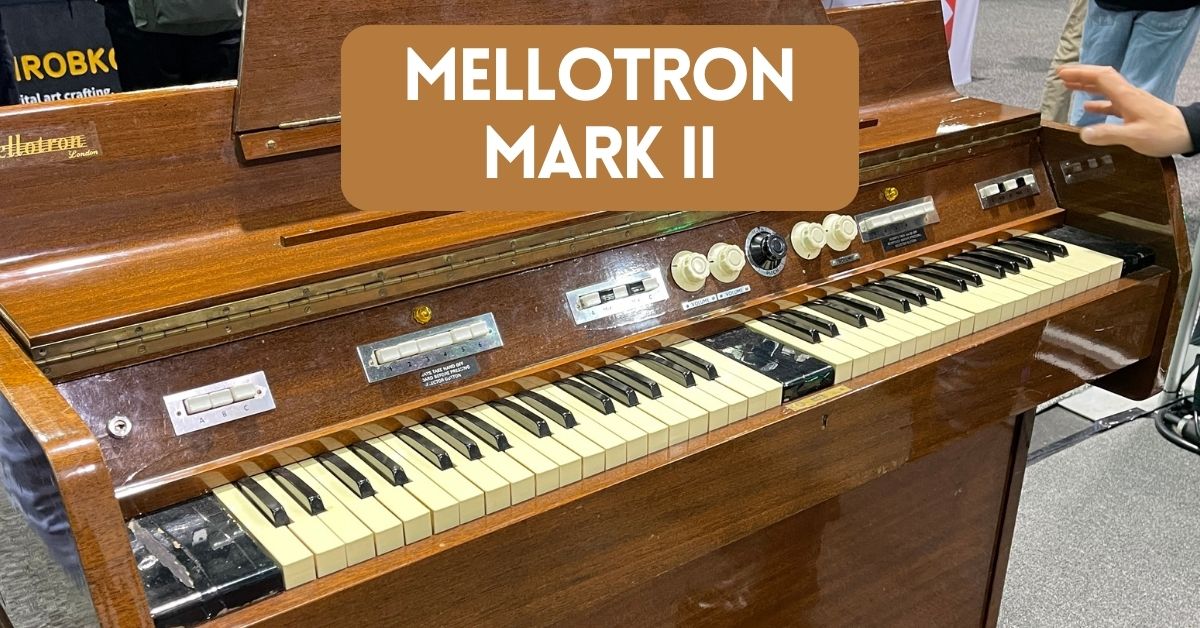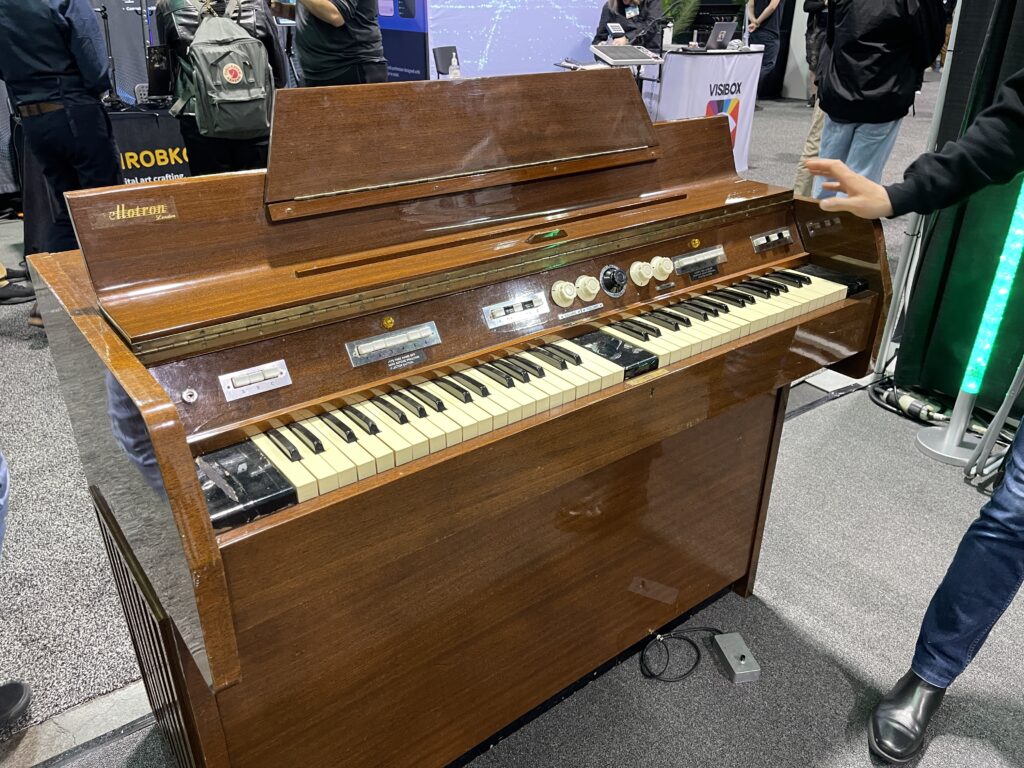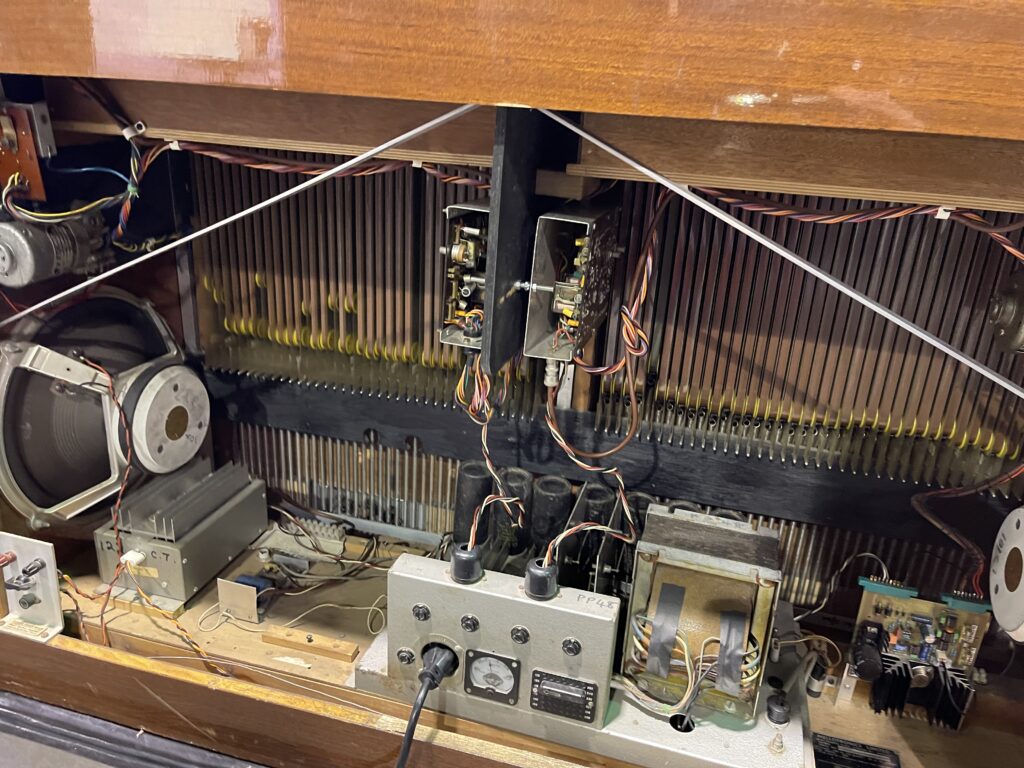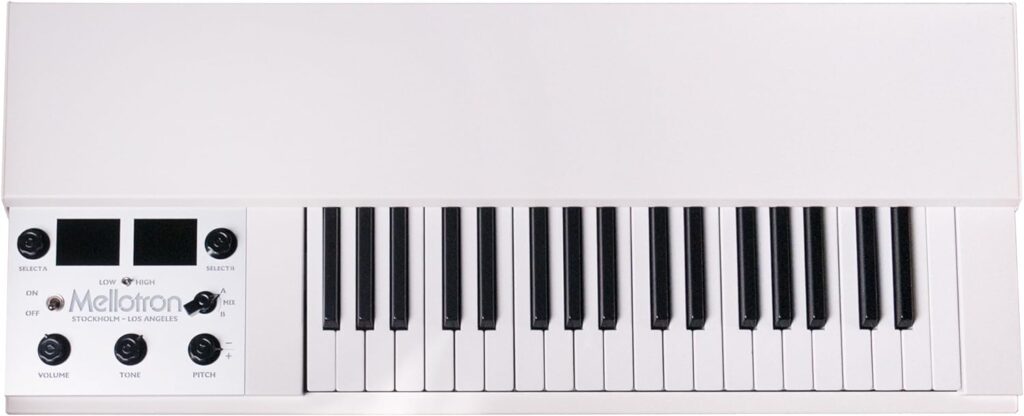The Mellotron Mark II was quite the beast of a keyboard when it was first introduced to the music world in the late 1960s. With its unique tape-loop playback mechanism, it was both innovative and cumbersome to work with. Nevertheless, it quickly caught on with musicians from all genres, especially rock bands of the time. It’s a sound I often use in my compositions and recordings, albeit in digital form. In this blog post, we’ll look at famous songs and bands that used the Mellotron Mark II and how it helped shape their sound.
Azure Hills Music contains affiliate links and is a member of the Amazon Services LLC Associates Program. As an Amazon Associate, we earn from qualifying purchases at no extra cost to you when you purchase using one of these Amazon links. Read our disclaimer and privacy policy for more information.
An Overview of the Mellotron Mark II
If you are a keyboard player and a fan of classic rock music, then the Mellotron Mark II is a keyboard instrument that you should definitely know about. This vintage keyboard, first introduced in the 1960s, is known for its unique sound used on many iconic songs of that era. It’s a classic instrument that continues to impact music in the current era.
The Mellotron Mark II keyboard instrument uses a tape loop mechanism to produce sound. It was invented in the UK in the early 1960s and quickly became popular with musicians and producers looking for a new, unique sound. The instrument features a keyboard with 35 keys and a range of sounds based on recordings of real instruments, such as strings, brass, and woodwinds. To play a sound, the player presses a key, which activates a tape loop of that sound. The tape loop then plays as long as the key is held down, creating a sustained, ethereal sound.
Two Keyboards on the Mellotron Mark II
The Mellotron Mark II is an iconic instrument with distinct left and right sides. On the left-hand side, there are two sections – Rhythm and Fill. However, on Q Division’s MKII, only the first bank retains this setup, with two sounds on the left. In all other banks, there is a single sound across each keyboard section.
Each piece of tape in the MK II has three tracks (A, B, and C), allowing for individual sound playback or mixing, except for the Rhythm side, which only plays one sound at a time.
For example, you can choose Bank 1 on the left and set the Rhythm side to track B to listen to the Dixieland beat. By setting the Fill to mix follows A and B, you can enjoy the Swinging Flutes and the Trombones. On the right side, select Bank 3 and mix tracks A and B to hear the MK II and M300A Strings.
Alternatively, you can use one sound at a time on each side, the most common way to use the MK II. Its versatility and unique features make it a beloved choice among musicians.
Checking out the Mellotron Mark II at NAMM
I was surprised to see an exhibit with Mellotron keyboards during a visit to the NAMM show in Anaheim, California. Most instruments on the floor were modernized digital versions that paid homage to the classic tape-based instrument.
But on one end of the exhibit was an original Mellotron Mark II. The back side was open so conference attendees could see the tape mechanism. So cool to see.
Mellotron Mark II Influenced Classic Songs
In the 1960s, the Mellotron was a revolutionary instrument. It allowed keyboard players to bring in sounds previously only available via expensive studio session musicians. While not 100% authentic, given the limitations of the technology, it was a game changer to have realistic flutes, strings, horns, and more at the touch of a keyboard.
Here are just a few classic songs that used various versions of the traditional Mellotron instrument.
The Beatles – Strawberry Fields Forever
One of the most iconic examples of the Mellotron Mark II is on The Beatles’ classic song “Strawberry Fields Forever.” The Mellotron’s flute tape produced the haunting flute/string sounds that opened the song, which was manually manipulated to create the desired effect. This use of the Mellotron helped set the standard for its use in psychedelic rock music.
The Mellotron Mark II was also present on the Magical Mystery Tour album.
King Crimson – In the Court of the Crimson King
Prog-rock pioneers King Crimson made prolific use of the Mellotron, particularly on their debut album “In the Court of the Crimson King.” The opening track, “In the Court of the Crimson King,” features a Mellotron choir sound that sets a dark and ominous tone for the rest of the album. The Mellotron’s ability to create massive, layered sounds made it a go-to for many prog-rock bands of the era.
Genesis – Watcher of the Skies
Genesis, another prominent prog-rock band, used the Mellotron on several early albums. “Watcher of the Skies,” from their 1972 album “Foxtrot,” features a Mellotron intro that gives way to an epic, symphonic sound that perfectly suits the majestic nature of the song. Keyboardist Tony Banks reportedly used the Mellotron to achieve a more authentic orchestral sound in the absence of a real orchestra.
The Moody Blues – Nights In White Satin
The Mellotron’s ability to emulate orchestral instruments made it a popular choice in orchestral rock, exemplified by The Moody Blues’ classic hit “Nights In White Satin.” The song’s famous orchestral interlude was created using the Mellotron’s string and flute tapes. The Mellotron’s flexibility in sound creation allowed The Moody Blues to achieve a more dynamic sound than was typically possible with a standard rock band lineup.
Elton John – Island Girl
In the late 1970s, I remember listening to the Elton John album, “Rock of the Westies,” and reading the liner notes. In the song “Island Girl,” a Mellotron is used. But I didn’t hear any of the classic tones I associated with this instrument. But sure enough, there is a Mellotron present. It may not be the Mark II version, but on this song, the Mellotron brings the sound of the vibes. At the time, it hit me as new and cool.
Radiohead – Paranoid Android
Even modern bands have used the Mellotron, none more so than Radiohead. On their landmark album “OK Computer,” the track “Paranoid Android” features a haunting Mellotron choir sound that fits perfectly with the song’s eerie, disjointed vibe. Radiohead has continued to utilize the Mellotron throughout their career, cementing its place as a timeless instrument in rock music.
Modern Mellotron M4000D Mini Keyboard
While most of us will never obtain a vintage Mellotron Mark II, we can still enjoy the sounds and playability of a Mellotron instrument. Today, one available version is the Mellotron M4000D Mini Keyboard.
This new digital version offers the same features, sounds, and front panel as the M4000D. It comes with a semi-weighted velocity-sensitive Fatar piano-style keyboard.
Purchase Mellotron M4000D Mini Keyboard
Conclusion:
The Mellotron Mark II’s impact on music has been significant. Its unique sound has influenced countless musicians and become a symbol of the psychedelic rock era. Today, there are still musicians who use Mellotrons in their music, either as a tribute to the past or as a way of incorporating its unique sound into their work.
The Mellotron Mark II may not be a commonly used instrument in modern music, but its legacy remains. Providing a new way to create layered sounds and emulate orchestral instruments helped push rock music in new and creative directions. From The Beatles to Radiohead, the Mellotron has left its mark on some of the most iconic musicians and songs of all time. And with renewed interest in vintage instruments and sounds, we may see a resurgence of the Mellotron in the years to come.
#mellotron




